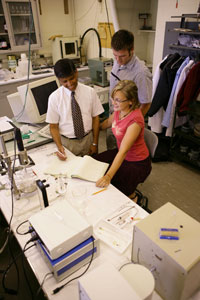Binding a photoactive molecule (e.g., pyrene) to metal nanoparticle enhances the photochemical activity and renders the organic-inorganic hybrid nanoassemblies suitable for light-harvesting and optoelectronic applications. The nature of charge transfer interaction of fluorophore with gold surface dictates the pathways with which the excited state deactivates. Obtaining insight into energy and electron transfer processes is important to improve the charge separation efficiencies in metal-fluorophore nanoassemblies and photocatalytic activity of metal-semiconductor composites.

The ability to functionalize gold nanoparticles with photoactive molecules has opened new avenues to utilize these nanoassemblies in light energy conversion systems. By suitably modulating the fluorescence of the surface bound fluorophore these nanoassemblies can be tuned to design sensors, display devices and biological probes. Molecular architecture of inorganic and organic hybrid structure in future will play a crucial role in tailoring the requirements of next generation nanodevices.
Issues
Our Research
Focus.
To design heterogeneous assemblies consisting of carbon nanostructures (fullerenes, carbon nanotubes etc) , semiconductor nanostructures, metal particles and sensitizing dyes for harvesting light energy
-
To understand the properties of a surface bound molecule and obtain valuable information concerning the charge transfer interactions and understand the role of gold nanoparticles in storing and shuttling of electrons.
-
To improve photoinduced charge separation in donor-acceptor type dyads and triads by binding them to metal nanostructures and/or semiconductor composites
-
To employ donor-acceptor based supramolecular systems (for example, fullerenes and porphyrins) and molecular clusters for in organic photovoltaic cells.
Recent
Progress
- Investigated photoinduced energy and electron transfer processes on gold nanoparticles and their modulation using external electrochemical bias
- Demonstrated the ability of 2-8 nm diameter to store electrons and undergo charge quilibration with semiconductor (TiO2 and ZnO)
- Achived a photoconversion efficiency (IPCE ) of 60% and power conversion effeciency of 2% using Au-Porphyrin_C60 based molecular clusters.
- Designed inorganic-organic hybrid assemblies for photoelectrochemical conversion of light energy
- Macroscopic alignment of carbon nanotubes and their deposition as a thin film using electric field.
Selected
Publications
Robel,
I., Bunker, B. and Kamat, P. V., SWCNT-CdS nanocomposite as light
harvesting assembly. Photoinduced charge transfer interactions. Adv.
Mater., 2005, 5, in press.
Hasobe,
T., Fukuzumi, S. and Kamat, P. V., Ordered Assembly of Protonated
Porphyrin Driven by Single Wall Carbon Nanotubes. J- and H-Aggregates
to Nanorods. J. Am. Chem. Soc, 2005, 127, 11884 - 11885.
Barazzouk, S., Kamat, P. V. and Hotchandani, S., Photoinduced Electron Transfer between Chlorophyll a and Gold Nanoparticles. J. Phys. Chem. B, 2005, 109, 716-723.
Hirakawa, T. and Kamat,
P. V., Charge Separation and Catalytic Activity of Ag@TiO2
Core-Shell Composite Clusters under UV-Irradiation. J. Am. Chem. Soc.,
2005, 127, 3928-3934.
Subramanian,
V., Wolf, E. E. and Kamat, P. V., Catalysis with TiO2/Au
Nanocomposites. Effect
of Metal Particle Size on the Fermi Level Equilibration. J. Am. Chem.
Soc.,
2004, 126, 4943-4950.
George Thomas,
K., Barazzouk, S., Ipe, B. I., Shibu Joseph, S. T. and Kamat, P. V.,
Unidirectional Plasmon Coupling through Longitudinal
Self-assembly of
Gold Nanorods. J. Phys. Chem. B, 2004, 108, 13066-13068.
George Thomas, K. and Kamat, P. V., Chromophore Functionalized Gold Nanoparticles. Acc. Chem. Res., 2003, 36, 888-898 (Review Article)
Hasobe, T., Imahori, H., Fukuzumi, S. and Kamat, P. V., Quaternary Self-Organization of Porphyrin and Fullerene Units by Clusterization with Gold Nanoparticles on SnO2 Electrodes for Organic Solar Cells. J. Am. Chem. Soc., 2003, 125, 14962-14963.
Kamat, P. V., Barazzouk, S. and Hotchandani, S., Electrochemical Modulation of Fluorophore Emission at a Nanostructured Gold Film. Angew. Chem. (Int. Ed.), 2002, 41, 2764-2767.
In
Popular Press
Reactive Reports: Fullerenes
on Film
 |
 |
 |
